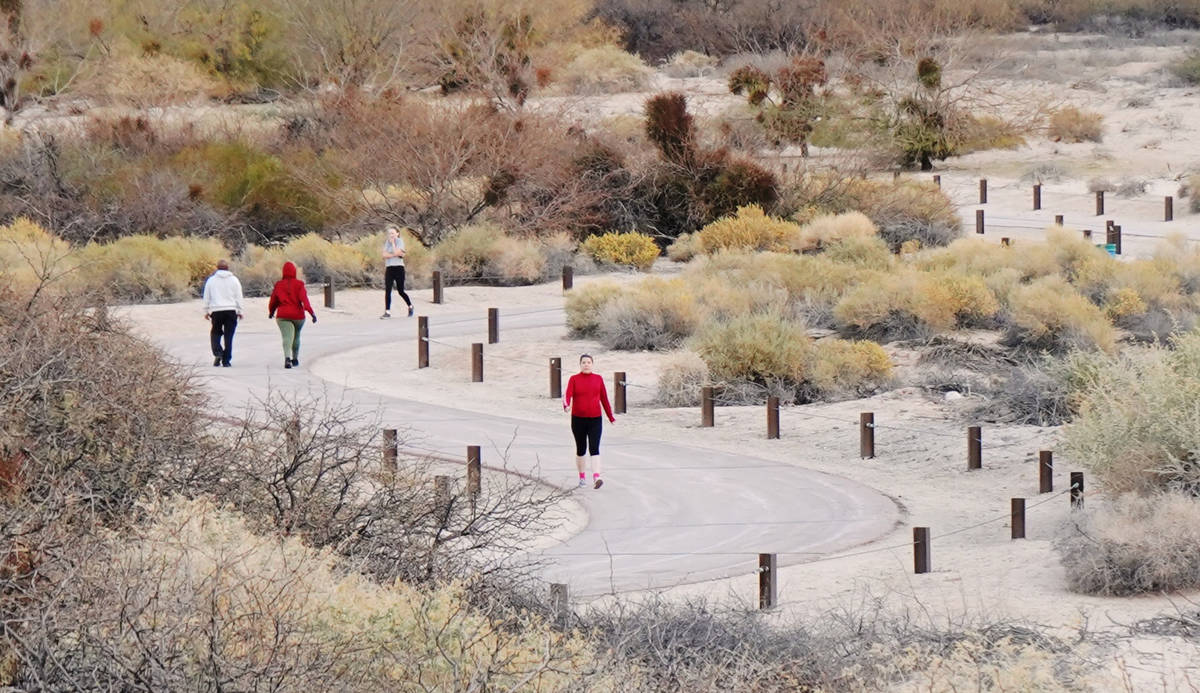Sunset Park is a great escape for people, good spot for critters
For many Southern Nevadans, Sunset Park holds memories of athletic rivalry and family fun. A collage might include images of locals fishing, playing basketball, attending company picnics, enjoying children’s birthday parties, attempting a round of disc golf and strolling around the park’s lake.
Located at Sunset Road and Eastern Avenue just to the southeast of McCarran International Airport, the 54-year-old park offers something for everyone. The 324-acre public space has 2½ miles of desert pathways and another 1-mile course that circles the lake. The park caters to those playing volleyball, baseball, softball or tennis; people operating remote-controlled boats; and even time travelers outfitted in costumes every October in their quest to rejoin Renaissance times.
During the pandemic, visitors have been flocking to a grassless area of the park, developed only a decade ago, to walk, jog or just enjoy an outdoor escape.
The Dunes Discovery Area on the south end of Sunset Park used to be a giant, mysterious patch of desert into which rabbits regularly darted. That territory still looks like the dusty desert that it is, but trails, wildlife encounters and interpretive signs help visitors understand the significance of those last natural sand dunes in an otherwise urban slice of Clark County.
An artsy overlook in the same area is the first thing visible from an adjacent parking lot south of Sunset Lake. Mesquite trees frame the area’s entrance, where visitors can find multiuse trails or begin a short ascent to the overlook with its panoramic views of sand dunes that used to cover much of what’s now heavily populated Paradise Valley.
Influenced by the get-your-10,000-daily-steps pressure campaign, I headed left to get my exercise along a 12-foot-wide paved path that meanders through the dunes area. The trails, lined by short cable fencing to discourage people from walking on the dunes, have been a social distancing hit with walkers and runners. Friends, couples and families have been walking and talking on the trails morning, noon and late afternoon during the milder months of the pandemic. Some ride bikes, and others push strollers carrying little ones or dogs.
Abundant wildlife
Beyond the paved paths, the wildlife is on display for anyone walking past. Gambel’s quail, shy ground birds whose male members don a handsome feather tapestry complete with a question-mark-like head plume, are typically the easiest critters to see on a Desert Dunes Area walk. Coveys of quail can be seen foraging for food and fleeing perceived and real enemies. Desert cottontails, rabbits whose pompom tails look like cotton, are easy to spot, as are ground squirrels.
Along the path, an informational panel explains that the plentiful mesquite trees among the dunes have produced edible beans that are a reliable food source for desert dwellers. Critters living at Sunset Park can be seen collecting mesquite beans or chewing on new mesquite growth.
Signs warn of coyotes in the area, and I’ve seen a few in a less-traveled part of the park just northeast of the Dunes Discovery Area.
Black-tailed jackrabbits the size of small dogs or cats are fairly easy to spot under trees or in between dunes. Their ears stand tall, and their powerful hind legs are poised for their next race for survival.
Among the desert birds that visitors might see is the greater roadrunner, an obvious dinosaur descendant with a sharp beak, flashy face, fierce look and long tail. They can be seen running across interior park roads or walking along the perimeter of a sprawling bush. They’re on the prowl mostly for lizards and insects to eat.
Territorial northern mockingbirds are abundant in a park filled with animals and plants that have adapted to the extremes of the Mojave Desert.
Another bird that’s been relatively plentiful this winter is the phainopepla because of the presence of mistletoe berries, a favorite food. Males and females have crests that make them stand out from similarly perching mockingbirds; the males are a nearly iridescent black, and females are a dark gray. Both have red eyes.
The crissal thrasher, a medium brown bird with a cartoonishly curved beak, is another desert specialty that lives in and occasionally can be seen in the dunes habitat.
A couple of Southern Nevada regulars — Anna’s hummingbirds and verdins — are frequently seen and heard on walks there.
History lesson
The Desert Dunes Area has shade, food and access to water, making it a hospitable spot for critters in an otherwise harsh environment. For people, it’s an open-air escape and nurtures an appreciation of the wildlife and history of Sunset Park.
A history walk includes panels with black-and-white photographs and words that tell part of the park’s story en route to the top of Dunes Overlook. After reading about the roles that Paiute Indians, ranchers and casino owners played in Sunset Park’s past, visitors are met near the top of the overlook by the smiling face of Mary Habbart.
Habbart is posing in a photograph taken three years after her unrelenting efforts persuaded politicians to buy the old Houssels Ranch and turn it into what became a massively popular public park.
Today, Sunset Park carries on as a lively setting for family memories, merrymaking, game-playing and, now, wildlife appreciation.



























